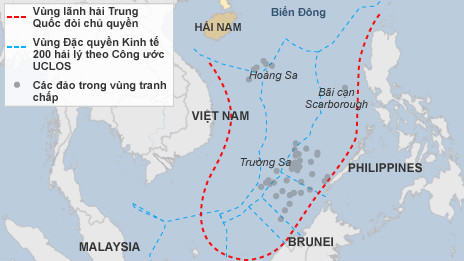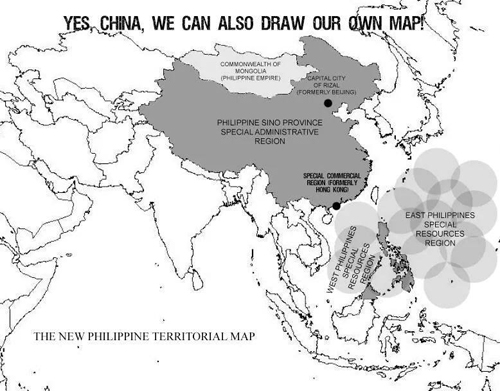|
Behind the vague
cow-tongue line established by China
After the Hunan publishing house released a vertical
map with the 10-dash line, both Chinese and foreign scholars criticized the
bogus map.
China's bogus
U-shaped line in the East
Sea.
General Daniel Schaeffer, former French military
attaché to China, Thailand and Vietnam said that the new map was
an unreal curtain to hide the truth inside. What is that truth?
Gen. Daniel Schaeffer said that before 2009, the
Chinese government had never officially referred to the cow tongue line as
the impregnable boundary of Chinese sovereignty in the East Sea.
They had always maintained the symbol of this line,
from 11 to 9, and then 10 dashes, causing confusion over China's
claims, making it difficult for the countries in the region to cope with.
In 2009, in a note sent to the UN Secretary General, China
attached the 9-dotted line map without clear explanation.
Back in 1909, the governor of Guangdong
sent some warships to conduct surveillance in Vietnam’s
Hoang Sa Archipelago (Paracel
Islands) in the name of
the Qing Dynasty, but it was actually the local government.
The French learned a serious lesson from the vague
behavior of China.
If facing fierce reaction from France, they would blame the
incident as the “mistakes” of the local government. If not, they would take
stronger acts. In the 1990s, China
repeatedly used the same trick against Vietnam
in the East Sea. They created tensions and blamed
the local authorities.
The vertical map published by the Hunan
publishing house is also a product of a province in China, with
the 10-dash cow tongue. The Chinese Ministry of Foreign Affairs said,
"The world should not pay attention to this map”. And others understand
the reason.
Like the previous maps with the 11 and 9 dashes, the
new map uses simplified Chinese and Latin, not ancient scripts.
Gen. Daniel Schaeffer pointed out China's intentions: "In such conditions,
we can understand that it is the boundary of China’s
territorial waters, and the entire area belongs to China. It is likely the boundary
that China
sets for "disputed areas" so as to more easily seize them in the
long run".
The French general who lived in China for a long time discovered that China does
not really believe in the cow tongue. He wrote in the Diplomatie journal:
"I've heard a lot of very strange statements that the cow tongue was not
created by the PRC. It is the legacy of the nationalist institution before.
So like it or not, they cannot let it go because no one wants to be blamed of
being "unpatriotic" if they cannot occupy over 2 million km2 inside
the cow tongue in the East Sea."
Ton Van, a Chinese scholar at the Stimson Institute
(US), has repeatedly announced to the world the absurdity of the cow tongue.
She said: "Despite the lack of legal grounds, China
has remained a ‘fuzzy strategy’ and is determined to use force to assert
sovereignty over the East
Sea. The events in the
Paracel in 1974 and in the Spratly in 1988 demonstrate China's
intentions."
"China
understands very clearly the opposition of cow tongue with the UN Convention
on the Law of the Sea (UNCLOS), thus they have been investing in the search
for legitimacy for the history rights, but they have not yet succeeded. Many
Chinese policy-makers have a clear understanding of the weaknesses of China’s
legal arguments and raised objections but the side of those who support the
viewpoint of ‘having weak arguments than having nothing’ has increasingly
prevailed. Therefore China
is very careful to not detail what they claim for sovereignty within the cow
tongue, and just leave it vague to make room for negotiations in the
future."
According to Ton Van, the popular view of China's
rulers is: "Weak legal arguments will be supported by strong national
power."
A map ridicules the cow tongue
in a Filipino newspaper by showing China as a province of this
country.
Also in Diplomatie, Daniel Schaeffer said that there
are two "schools" of the U-shaped line in China. The first “school” is
"legal respect," represented by Prof. Lihai, who was appointed
judge of the court of international maritime law in August 1996. The second
“school” is called "traditional" and it is supported by the Chinese
government.
The first “School" is the progressive tendency in China that
has been supported by the young researchers and young intellectuals in this
country. This is most evident in social forums on Sina.com and other common
blogs.
According to the French expert Daniel Schaeffer, Prof.
Lihai has significantly contributed to the trend of denying China's cow
tongue. In 2000, he suddenly died but the tendency "legal respect"
has not been diminished. China's
government has repeatedly expressed dissatisfaction and raised difficulty or
shut down many blogs but they cannot extinguish "the voice of
reason."
Prof. Luc Tien of the Chinese
Academy of Social Sciences has views
different from the perspective of the Chinese government on the East Sea.
His research papers and articles were published in the Hong Kong Public
Newspaper.
In the article, the author concluded that the dispute
in the East Sea has grown to the extent of
damaging the interests of the parties, so it needs the participation and
efforts of the parties to change this trend. His views are the views of the
Association of Southeast Asian Nations (ASEAN) about the East Sea
dispute, which wins the support of many countries around the world.
In the South China Morning dated June 26, 2014, Prof.
Ly Vinh Long, from the Xiamen University said: "The abandonment of the cow
tongue will completely deal with the vague situation, making negotiations
more objectively and reliably and helping rebuilt China’s image as a more reliable
partner in the eyes of its neighbors and the international community."
He said that although the Chinese government is determined
to pursue the cow tongue, in the end the myth cannot last to force China to be a
prisoner for that illusory myth forever!
The Wall Street Journal quoted global military affairs
commentator Wu Ge on his verified Weibo account: “If the U.S. wanted to include Hawaii
and Guam, and England and France wanted
to include their overseas territories, they could have just shown a map of
the entire world. Is it really useful putting [these islands] together now?
It is nothing but obvious ambition. What [Hunan Map Press] did only shows
that the extreme leftists chime in easily with blind patriotism.”
VietNamNet Bridge
|


Không có nhận xét nào:
Đăng nhận xét